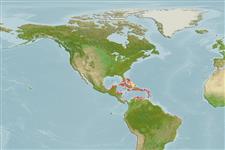Common names from other countries
Classification / Names / Names
Common names | Synonyms | Catalog of Fishes (gen., sp.) | ITIS | CoL | WoRMS
Environment: milieu / climate zone / depth range / distribution range
Ecology
Benthic; depth range 0 - 1 m (Ref. 83435). Tropical
Western Central Atlantic.
Length at first maturity / Size / Weight / Age
Maturity: Lm ? range ? - ? cm Max length : 10.0 cm TL male/unsexed; (Ref. 289)
Maximum depth from Ref. 110502. Epibiotic (Ref. 110502). Intertidal; very common on open shore (Ref. 289); common in the zone between tides in the rocky coast, mainly on rocks of arenaceous; adheres with great force to rocks (Ref. 292); intertidal, spray zones of rocky shores (Ref. 2022, page 122).
Life cycle and mating behavior
Maturity | Reproduction | Spawning | Eggs | Fecundity | Larvae
Members of the class Polyplacophora are mostly gonochoric. Life cycle: Eggs hatch into lecitotrophic planktonic trocophore larvae (no veliger stage) which later metamorphose and settle on the bottom as young adults.
Burghardt, G. and L. Burghardt. 2006. (Ref. 281)
IUCN Red List Status (Ref. 130435)
CITES status (Ref. 108899)
Not Evaluated
Not Evaluated
Human uses
| FishSource |
Tools
More information
Age/SizeGrowthLength-weightLength-lengthMorphologyLarvaeAbundance
Internet sources
Estimates based on models
Preferred temperature
(Ref.
115969): 26.3 - 28.4, mean 27.3 (based on 199 cells).
Vulnerability
Low vulnerability (10 of 100).
Price category
Unknown.
